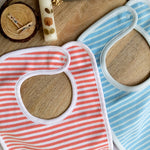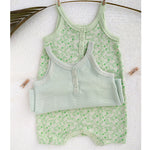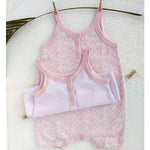You have no items in your shopping cart.
What are diaper rashes?
One of the most common skin problems that affect babies and toddlers is diaper rash. Also called Irritant Diaper Dermatitis (IDD), this is a result of regular use of diapers.
The condition occurs when skin is constantly exposed to wetness. Most of the disposable diapers in the market last for 8+ hours. As a result, kids keep wearing the same diaper for hours together. Even though these diapers are marketed as being dry, the inner suface starts getting wet after the first few times of peeing. When the skin around the genitals, perineum, and buttocks keeps touching the wet diaper surface for a long time, rashes are inevitable.
Studies estimate that up to 65% of babies could develop diaper rashes in their lifetimes. Though the severity of the rashes reduces in 2-4 days, constant exposure to wetness may lead to the development of chronic nappy rashes.
Why are diaper rashes problematic?
Most babies and toddlers have gentle skin. As a result, they struggle with really sensitive skin in the first few years and this increases the risk of diaper rashes.
Here is why diaper rashes are problematic:
- The rashes cause pain and irritation in the skin
- Diaper rashes lead to skin inflammation and redness
- Severe diaper rashes lead to broken skin, blisters, and boils
- Rashes make the child cranky and disturbed all day long
- Rashes may lead to bacterial infections
- Rashes can spread to a larger surface and worsen with time
It is very important to prevent diaper rashes and if they appear, to treat the signs quickly.
Signs and symptoms of diaper rash
Here are some of the common signs of diaper rashes to be aware of.
- Tender and red skin
- Skin peeling
- The baby keeps itching the affected area
- Inflammation and redness around the perineum, buttocks, genitals, and inner thighs
- Baby seems uncomfortable, cranky, and fussy
What causes diaper rashes?

Constant exposure to urine – The pH level of baby pee is high and pee contains ammonia that can react negatively on the skin’s surface. The outermost layer of the skin is called the stratum corneum. This layer breaks down in the presence of ammonia and this leads to rashes.
Chafing and rubbing – Slightly healthier babies have layers of fat in the body and this causes constant rubbing and chafing of the skin, especially when the baby starts crawling or walking. The chaffing can lead to breaking down of the skin layers and exposure to wetness from diapers makes the condition worse.
Type of foods – Sometimes, introducing new foods can change the pH value and the composition of pee and poo and this can lead to the development of nappy rashes. This is why most kids struggle with this condition between 6 and 9 months. Once their bodies get used to the new types of foods, the condition gets better.
Existing bacterial or yeast infections – If the baby already has some kind of bacterial or fungal infection in the body, the wetness created by diapers becomes breeding grounds for these infections and the condition can get worse.
Existing skin conditions – Babies born with existing skin conditions like eczema or atopic dermatitis may already have very sensitive skin and this can increase the risk of developing diaper rashes.
Self remedies for diaper rashes
Diaper free time
This is one of the most effective home remedies for diaper rash you can try out. The minute you note skin rashes, stop using diapers. Give the baby a couple of days of diaper-free time to let the skin heal. Even after that, use diapers only when absolutely necessary.
Change diapers often
If you have to use disposable diapers, change them often. Do not leave them on for more than 3-4 hours. This brings down the risk of rashes.
Consider cloth diapers
Cloth diapers with inserts are as effective as disposable diapers these days. They come with the advantage of not having harsh chemicals in them. If you really want to use diapers overnight or when you travel, consider cloth diapers. These are safer than disposable ones. Even with cloth diapers, it is advised to change the insert and the outer cover often.
Consider cloth nappies
Cloth nappies are the most economical, safe, and healthy alternatives to daytime diapers.

Small babies pee a lot. Instead of putting on disposable diapers that keep touching the skin for hours, opt for cloth nappies that soak pee and poo and can be washed and reused again. For newborns, having a set of 15-25 cloth nappies is enough to handle 1-2 days of pee and poo. You can wash these, dry them out in the sun and use them again the next day.
Did you know that our cloth nappies are made of 100% organic cotton? These get softer with every wash and can be reused for years together.
Clean pee and poo regularly – In the list of diaper rash treatments that work, maintaining good hygiene is important. Clean pee and poo regularly. You can use plain water to keep the areas around the genitals clean. Pat dry the skin after washing.
Avoid using wet wipes – Wet wipes are easier to clean the baby’s private parts after an episode of pee or poo. However, do know that many wet wipe brands use artificial fragrances and other additives to these wipes? These can cause or aggravate diaper rashes in babies.
Use flowy, soft clothes – Soft, flowy clothes don’t restrict movement in the little ones and allow free airflow. Use 100% cotton clothes and this will help bring down the risk of rashes.
Other solutions
Use generous amounts of diaper rash cream – A diaper rash cream acts as a protective barrier between the skin and the wet surface. Ask your doctor for diaper rash cream suggestions and use the product every time you put on a diaper.
Some doctors ask parents to use the two-part application trick. Here, the rash cream is applied to the skin, and an extra layer of protection like petroleum jelly is applied over it. This is more effective.
Prescription solutions – If diaper rashes reoccur constantly and the skin gets severely damaged, then your pediatrician can prescribe topical antibiotics/antifungal creams or hydrocortisone creams. These creams can help bring down the intensity of the condition.
Do not buy over-the-counter creams and lotions without talking to your pediatrician first. The medications need to be chosen depending on what is causing the rash.
Takeaways

Disposable diapers are absolutely convenient to use. However, they come with a lot of long and short-term problems for the baby and the environment. Disposables are the third-largest category of products that are thrown in landfills globally!
Invest in cloth diapers and soft cotton nappies and use these instead. These minimize the risk of diaper rash and other skin infections.
If you need to use disposable diapers, try switching brands. Few brands may aggravate skin rashes while others may be gentler on the skin. You will only know after you try. Diaper-free times help the baby understand bodily needs and potty train faster too.
The trick to minimize the effects of diaper rashes is to identify the condition early and treat it.







